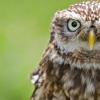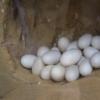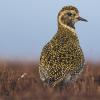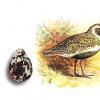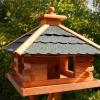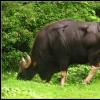Nightingale cricket. Nightingale cricket (locustella luscinioides). Spread of nightingale cricket
The distribution of the nightingale cricket is very peculiar. Both subspecies isolated from this cricket (European and Central Asian) have not continuous, but spotted areas. Such a structure of modern ranges of passerine birds is a very rare occurrence. It testifies that during the Ice Age the area of the nightingale cricket was not only dissected into the two mentioned parts and severely shifted to the south, but also that each of these parts was probably fragmented into several isolated areas. Thus, the modern structure of the range of this species characterizes it as a southern, relatively heat-loving (compared to the river and common crickets) form.
The poetic name of the species - nightingale, unfortunately, has nothing to do with the song of this bird and is associated with its color, reminiscent of the color of a nightingale. More precisely, it should be called reed or reed cricket. Throughout its range, the nightingale cricket is a migratory bird. In most areas of habitat arrives from the second half of April. Mass arrival - in early May.
From the very first days of arrival, males, appearing at the nesting sites somewhat earlier than females, occupy nesting sites and begin to sing intensively. The nightingale cricket is even more picky about the choice of nesting sites than the river cricket. The main feature of its nesting habitats is swampy, inaccessible, overgrown with willows, reeds and rich emersed vegetation, the shores and swampy islands of reservoirs. Where this bird does not find swamps and floodplains, it chooses puddles overgrown with sedge and bushes. The nightingale cricket also nests in wet meadows overgrown with willow and sedge, along the swampy banks of rivers, ponds and lakes. You can find this bird on swampy edges, among light forests in floodplains and along ditches overgrown with reeds.
The nightingale cricket is a very secretive and at the same time warlike bird. Despite the fact that this cricket often nests in groups (spots) at a small (40-70 m) distance from each other, males fiercely defend their territories and often start fights. At this moment, they lose their usual caution. Therefore, it is much easier to witness a cricket fight than to see a calm bird. In group settlements, an ordered hierarchical structure develops. Before the arrival of females, nightingale crickets sing on the tops of reeds or bushes, like many other crickets and warblers. The song of the nightingale cricket, although it retains distinct similarities with the song of other European crickets, characterizes it as an older form than the river and common crickets. If the song of the other two crickets is monolithic and monotonous, then the nightingale at the beginning of the song, as it were, picks up separate sounds, only then merging them into a real cricket trill. The song begins with jerky smacking sounds, vaguely reminiscent of the main call of this species; these sounds become more and more frequent, turning into the characteristic "zirrrr". This nature of song construction allows not only to establish its origin from sparsely spaced calls, but also to connect this origin with the call system of the bird. At the height of the mating season, the nightingale cricket sings for whole days, day and night. Sings the entire period of incubation and even feeding chicks. From the first days of July, shortly after the mass departure of the chicks, singing can only be heard in the morning and evening. After the end of current singing, during the period of incubation and feeding of chicks, this cricket sings, hiding in the depths of thickets, and it is difficult to see it.
It is interesting that the Asian subspecies, in addition to the already indicated habitats, often nests in the heaps of reeds and unusually skillfully hides, as if burying, its nest in the thickness of the reed heap. The holes of such nests are flush with the surface of the heap and are masked so cleverly that only one entrance to the nest remains visible. Birds of the Asian subspecies also nest in reed fences, but always near water.
The nest is built low (no higher than 30 cm) above the surface of water or land. Sometimes it is built on the ground in a small depression of a hummock and strengthens among the stems of herbaceous plants. A nest is formed from dry stems and leaves of reeds, reeds or other marsh plants. The outer walls of the nest are often loosely and loosely woven, the inner walls are much denser and are made of thin dry stems. The nest looks like an elegant hemisphere with a deep, smooth, sometimes even shiny tray. Occasionally, it is covered from above with a bunch of dry roots or grass, which makes it almost invisible.
Clutch of 4-5 white eggs with brown spots in May - June. One female incubates the clutch, she also feeds the chicks. During incubation, the male regularly brings food to the female. Feeding of chicks lasts 12-14 days. Like other crickets, the nightingale's food consists mainly of small insects and their larvae (reed aphids, flies, mosquitoes, including weevils, small butterflies and their caterpillars, as well as spiders).
The behavior of the nightingale cricket is peculiar. Hearing a noise or noticing danger, the cricket falls silent and instantly hides in the thickness of the reeds. Soon, soft sounds "ts ... ts ... ts" are heard from there - a warning signal about the danger, addressed primarily to the female. When excited, the cricket begins to add a slight crackle to the first signal. Gradually, the crackling becomes louder, and the bird begins to climb up the stalks of reeds. In moments of great anxiety, the nightingale cricket crackles and emits a hasty chime "chk-chk-chk-chk". With a female, he usually talks with a more calm urge "hick". Often this urge, sharply increased, becomes a signal of danger. Nightingale cricket feeds near the ground. During feeding, the song of the male is constantly interrupted. The cricket runs beautifully on the ground (does not jump), deftly slipping between the thick stems of plants and at the same time resembles a water chicken or a corncrake. In case of danger, he quickly hides in the thickest thicket. In August - September, nightingale crickets fly off for wintering.
When using site materials, it is necessary to put active links to this site, visible to users and search robots.
see also 18.17.5. Genus Crickets - Locustella
Nightingale cricket - Locustella luscinioides
It looks like a river cricket, but it is lighter above, with a reddish tinge, below almost or completely without streaks, there is almost no light eyebrow.
Breeds in damp coastal willow and reed beds in the south of the European part of Russia and Western Siberia. Clutch contains 4-5 white eggs with brown spots. The song is gradually increasing buzzing sounds "zirrrr", the cry is a sharp "chk".
Table 48 589 - Thrush warbler; 590 - reed warbler; 591 - marsh warbler; 592 - garden warbler; 593 - Indian warbler; 594 - black-browed warbler; 595 - badger warbler; 596 - aquatic warbler; 597 - slender-billed warbler; 598 - thick-billed warbler; 599 - common cricket; 600 - spotted cricket; 601 - song cricket; 602 - Okhotsk cricket; 603 - river cricket; 604 - nightingale cricket; 605 - taiga cricket; 606 - small motley.
- - In the West, it symbolizes a home oven. In China, it means summer and courage...
Symbol Dictionary
- - nightingale "...
Russian spelling dictionary
- - cricket genus. p. p. -scha - the same, Ukrainian. over, blr. sverch, other Russian. svrchk, Serbian ...
Vasmer's etymological dictionary
- - Common Slavic - svürk-. The word "" has been known since ancient Russian times as the name of an insect and is a common Slavic ...
Etymological dictionary of the Russian language Semenov
- - R. cricket/...
- - ...
Spelling Dictionary of the Russian Language
- - husband. Sverch psk. sverch old tsirkun, tsvirkun, tsiryukan; the insect Gryllus, which sparkles, whistles, chirps, rubbing its hard wings against its serrated legs; there is an oven cricket - field, forest and earthen ...
Dahl's Explanatory Dictionary
- - CRICKET, -chka, husband. A straight-winged insect that makes chirping sounds. S. on the stove. Every s. know your sixth. | adj. cricket, th, th. The cricket family...
Explanatory dictionary of Ozhegov
- - Nightingale, -vya, m. Brown-gray bird of this family. thrush, characterized by beautiful singing. Nightingale's trill. Nightingales are not fed with fables. Someone spills like a nightingale. ...
Explanatory dictionary of Ozhegov
- - Nightingale, nightingale, nightingale. adj. to the nightingale. Nightingale trills. Nightingale whistle...
Explanatory Dictionary of Ushakov
- - nightingale adj. 1. ratio with noun. nightingale I associated with him 2. Characteristic of the nightingale, characteristic of him. 3. Belonging to a nightingale...
Explanatory Dictionary of Efremova
- - Basilisk - nightingale day ...
- - See SILENCE - NOISE -...
IN AND. Dal. Proverbs of the Russian people
- - who. Narodn. Contempt. About a two-faced person. DP, 517...
- - who. Narodn. Unapproved About a two-faced person, a toady. Jig. 1969, 208, 220...
Big dictionary of Russian sayings
- - ...
Word forms
Nightingale Cricket in books
Cricket
the author Kozlov M ACricket
From the book Living Organisms - Human Companions the author Kozlov M ACricket To me, the deafening chirping of cicadas is more like the sound made when a fingernail is run over the teeth of a comb. Another thing is the song of the house cricket on an autumn evening, when the flame goes out in the fireplace. Remy Chauvin
nightingale evening
From the book Ugresh Lira. Release 2 author Egorova Elena NikolaevnaNightingale evening June park. The trill of the nightingale And the chirping of the restless birds. Here is the cherished bench Under the old fragrant linden. Let's sit side by side in the shade. Today nightingale evening! You whisper words of love to me And gently hug my shoulders. Listen, my dear, nightingale And be happy
nightingale garden
From the book Russian writers of the twentieth century from Bunin to Shukshin: a study guide author Bykova Olga PetrovnaNightingale Garden 1 I break layered rocks At low tide on a muddy bottom, And my tired donkey drags Their pieces on a shaggy back. We'll carry it to the railroad, We'll put it in a heap, and again hairy legs lead us to the sea, And the donkey starts screaming. And he screams, and he trumpets - it is gratifying that
nightingale house
From the book Noble Nests author Moleva Nina MikhailovnaNightingale's House Pushkin's house, Pushkin's museums, regular Pushkin's celebrations - and all the same as one and a half hundred years ago, riddles, blank spots in the biographical canvas, in the geography of the houses where the poet visited. We walk with Vadim Kozhinov along the back streets of the Arbat and once again
"Nightingale Floor"
From the book Richard Sorge - The feat and tragedy of a scout author Ilyinsky Mikhail Mikhailovich"Nightingale floor" When Richard once again visited the embassy, there was a surprise waiting for him in the hall. - Dear friend, I'm glad that we met again! - Eugen Ott was walking towards him. On the shoulders of his uniform were the new colonel's epaulettes. - Oh, with a promotion! -
Cricket
From the book Encyclopedia of Slavic Culture, Writing and Mythology author Kononenko Alexey AnatolievichCricket An insect that, according to legend, brings happiness and prosperity to the house. When a cricket sings while talking about business - a good omen. Cricket is the embodiment of home comfort and family happiness. Killing this insect was considered big
nightingale garden
From the book All masterpieces of world literature in brief. Plots and characters. Russian literature of the XX century the author Novikov V INightingale Garden Poem (1915) The hero of the poem - it is written in the first person - a worker; he comes to the sea at low tide to earn a living by hard work - with a pick and a crowbar to chop layered rocks. The extracted stone is carried on a donkey to the railroad. Both the animal and
Cricket
From the book I know the world. Insects the author Lyakhov PetrCricket Perhaps you have already heard the song of a cricket coming from somewhere under the stove in an old village house. During the day, he hides in some crack, and at night he gets out. It is difficult to see him, and even more difficult to catch, as he runs very fast on
* CRICKET
author Stykalin Sergey Ilyich* CRICKET Satirical and humorous magazine. Published in Gomel in 1922 (Source: Muratova, p.
CRICKET
From the book Soviet satirical press 1917-1963 author Stykalin Sergey IlyichCRICKET Children's humorous magazine. The only issue was published in 1937 in Moscow with the subtitle "Funny pictures for little guys." Published by Children's Publishing House of the Komsomol Central Committee. Printed on 16 pages, with multi-color illustrations. Originated instead of a humorous newspaper for children
Cricket
From the book Stone Belt, 1984 author Grossman Mark SolomonovichCricket Chiki-chiki-chiki-chok, A cricket sat on a pipe, Started counting holes: One, two, three, four, five, Five, four, three, two - It's time to go out
nightingale call
From the book Literaturnaya Gazeta 6425 (No. 31 2013) author Literary NewspaperThe nightingale's call Photo: Alexander BOBROV His word became part of Russia, and front-line songs were loved by everyone - from ordinary soldiers to Marshal Zhukov. “On a sunny meadow”, “Nightingales”, “We haven’t been at home for a long time”, “Where are you, my garden?”, “Migratory birds”, “Where are you now,
* ART * Alexander Timofeevsky, Tatyana Tolstaya Nightingale Garden
From the book Earth (September 2007) author Russian life magazine* ART * Alexander Timofeevsky, Tatyana Tolstaya The Nightingale Garden Dmitry Alexandrovich Prigov and the pantheon of Russian poetry Tatyana Tolstaya. Our theme is what is poetry? And if, say, she is God in the holy dreams of the earth, then was God in Prigov? I think yes, it was. And here
Nightingale Garden of the Golden Horde
From the book History of Russian Islam. Discourses on Northern Islam author Bukharaev RavilThe Nightingale Garden of the Golden Horde , what and
(Savi, 1824)
|
DescriptionThe nightingale cricket reaches a length of 14 cm and weighs 12–24 g. The tail is wide and rounded. The plumage is completely brown, without a pattern. The eyebrow is indistinct and short. SpreadingThe nightingale cricket is distributed from Western Europe to the Urals. The 140,000–370,000 breeding pairs are found primarily in Russia, Romania and Hungary. The bird needs long expanses of nutrient-rich lakes and swamps. Here, the old reed serves as a hiding place for her. She avoids areas heavily overgrown with shrubs. It winters in the Sahel, migrating primarily at night. BehaviorThe nightingale cricket is less secretive than the common cricket. He shouts in danger shortly “tsik”, at the nest “pit”. The chant is much deeper than that of the common cricket, and has shorter stanzas that are often accompanied by shorter, faster-paced "tik-tiktiktik... err" elements. When the nightingale cricket is frightened, it falls with its neck stretched up and its tail between its legs. NutritionThe nightingale cricket searches for insects and spiders in the reeds, while it climbs, often with the help of wings, up the stem or sits, clutching its paws, between two stems. reproductionNightingale cricket nests twice from May to June in extended thickets of reeds. It builds a large, partly covered nest of reed stems and leaves in a thicket of reeds just above the water. Write a review on the article "Nightingale Cricket"NotesLinksAn excerpt characterizing the Nightingale cricketSo far, I could not answer her, such a seemingly simple question, since I myself stood completely taken aback, not finding any explanation for this “absurd” phenomenon ...Stella quietly extended her hand to her twin and touched the same small fingers extended to her. I wanted to shout that it could be dangerous, but when I saw her satisfied smile, I kept silent, deciding to see what would happen next, but at the same time I was on my guard, in case something suddenly went wrong. - So it's me ... - the little girl whispered in delight. - Oh, how wonderful! This is really me... Her thin fingers began to glow brightly, and the "second" Stella began to slowly melt, smoothly flowing through the same fingers into the "real" Stella, who was standing near me. Her body began to thicken, but not in the same way as the physical body would, but as if it became much denser to glow, filled with some kind of unearthly radiance. Suddenly, I felt someone's presence behind me - it was again our friend, Atenais. “Forgive me, bright child, but you will not come for your “imprint” very soon ... You still have to wait a very long time,” she looked into my eyes more attentively. Or maybe you won't come at all... - How is it “I won’t come”?! .. - I was frightened. - If everyone comes, then I will come too! - I do not know. For some reason your fate is closed to me. I can't answer you, sorry... I was very upset, but, trying my best not to show this Atenays, I asked as calmly as possible: What is this “imprint”? “Oh, everyone, when they die, comes back for him. When your soul ends its “languishing” in another earthly body, at the moment when it says goodbye to it, it flies to its real Home, and, as it were, “announces” its return ... And then, it leaves this “ seal". But after that, she must again return back to the dense earth, in order to say goodbye forever to who she was ... and a year later, having said “last goodbye”, leave from there ... And then, this free soul comes here to merge with his left part and find peace, waiting for a new journey to the "old world"... |
|---|
The nightingale cricket belongs to the warbler family, the passerine order.
External signs of a nightingale cricket
The nightingale cricket is a small bird measuring 13–15 cm. The wingspan is 18–21 cm. Weight - 14-18 grams. The plumage is painted evenly. The upper body is brown, without greenish tints. The underside and chest are brownish on the sides.
The belly is white or whitish in the middle with a slight brownish tinge. The undertail is formed by long dense light brown feathers. Uppertail feathers have indistinct light areas. A thin light stripe runs along the outer side of the wing. Flight tertiary feathers are darker.
There is an almost imperceptible reddish "eyebrow" that runs along the dark eye. The tail is in the form of a fan. The beak is dark above, pinkish-yellow below. Paws are brownish with a pink tint. The coloration of the plumage of males and females is practically the same. Young nightingale reconciliations are slightly darker on top and rufous below than adult birds, with barely distinguishable mottled spots on the throat.
Listen to the voice of the nightingale cricket
The nightingale cricket differs from many other crickets in the absence of streaks on the chest, very long undertail feathers, a shade of feather cover below, a wide stepped tail, voice, and behavioral features.

Spread of nightingale cricket
The nightingale cricket is distributed in the central and southern regions of Europe, where it is a common species. Inhabits Central and Western Asia.
Found in northern Africa. Migratory species, migrates for wintering to tropical Africa in the Nile Valley, to the Euphrates swamps, as well as to the southern coast of the Mediterranean Sea. In Italy, it is distributed at altitudes up to 200 meters above sea level. The nightingale cricket forms three subspecies.
Nightingale cricket habitat
The nightingale cricket inhabits dense reed beds, as well as places with other near-water plants: reeds, cattails.
Chooses impassable thickets of plants, dense willows.
At the same time, it prefers to be near the water next to open creeks or wetlands. Keeps on islets of plant thick or along the edge of the reservoir.
For nesting, it chooses dry, non-flooded places or dense accumulations of dead dry reeds.

Features of the behavior of the nightingale cricket
Nightingale crickets constantly hide in impenetrable reed beds. Males often sit on the tops of reeds, reeds, bushes, large stones, or any kind of elevation. At the same time, they emit a long and monotonous buzz, similar to a squeak, of unwinding fishing line on a spinning reel. This feature gave the cricket its name.
Nightingale crickets skillfully move both on land and on fallen reed stalks. Males simply walk along the stems of plants, climbing to the very top of the reed. Birds walk, not climb, and can sit right on the stems for a long time, holding on to a separate stem with their paws. Warblers sit differently on the stem, placing their legs in a different way. This is how nightingale crickets are distinguished from other bird species by planting.
Reproduction of nightingale cricket
In the spring, during the breeding season, the males of the nightingale cricket sit on the stems of plants and sing day and night, not falling silent even in the hot season. Upon arrival, the males arrange real competitions in the skill of singing. In May or June, with their singing, they notify competitors of the occupied territory, thus they drive their rivals away from the nesting site.

The song begins with special sounds, similar to the crackling of bursting mud bubbles. This is followed by a more musical performance of trills, at first slightly muffled and slow, later loud and fast.
At the height of summer, nightingale crickets sing only in the early morning and evening.
In August, bird songs are heard very rarely. Male nightingale crickets always sing at the top of the reed. At the same time, they puff up the feathers on their throats, turn their heads in different directions and open their beaks wide. By the sounds of the song it is very difficult to determine the seat of the bird. At the slightest rustle, the nightingale cricket dives down the stem and freezes.
If the danger passes, then the bird again begins a timid song among the dense thickets. Then it gradually rises up and again sings at the top of the stem. A pair of crickets builds a nest in 2-3 weeks. The male brings building material: broken and bent reed stems up to 25 centimeters long, dry leaves and other plant material.
The female builds a large nest, it is located in a disguised place and hides among the reed leaves, usually at a height of up to 30 cm from the surface of a reservoir or swamp. The construction is loose, fragile, similar to a pile of last year's fallen cane. The tray is neater than the whole building. From above the nest is covered with straws from the rain.

In the second half of April, the female lays 3–5 small, about 2 cm eggs. They are white or slightly yellowish in color, covered with grayish or brown speckles, sometimes with black strokes. She incubates the eggs for 12-14 days. The male does not heat the clutch, but brings food to the female. The chicks appear in mid-May or June on the 11th–15th day and remain in the nest for another two weeks. Nightingale crickets usually have one or two clutches per year.
Nightingale cricket nutrition
The nightingale cricket feeds mainly on insects. Eats mayflies, dragonflies, small grasshoppers, as well as spiders, dung flies, caddisflies and caterpillars.
Conservation status of the nightingale cricket
Globally does not threaten. The nightingale cricket is a widespread and locally distributed bird species, but its nesting sites are scattered, with wide gaps in distribution. In Europe, the overall population trend in 1980-2011 was stable, based on preliminary data for 27 pan-European monitored countries. The estimated number of breeding pairs is 530,000-800,000, equating to 1,590,000-2,400,000 individuals. According to these criteria, the nightingale cricket does not belong to a species with a global threat to abundance. Europe is home to 50-74% of the world's number of birds of this species, although further confirmation of this estimate is needed. The nightingale cricket is protected under SPEC 4, BERNA 2, BONN 2 conventions.
If you find an error, please highlight a piece of text and click Ctrl+Enter.
Description
The nightingale cricket reaches a length of 14 cm and weighs 12-24 g. The tail is wide, rounded. The plumage is completely brown, without a pattern. The eyebrow is indistinct and short.
Spreading
The nightingale cricket is distributed from Western Europe to the Urals. The 140,000–370,000 breeding pairs are found primarily in Russia, Romania and Hungary. The bird needs long expanses of nutrient-rich lakes and swamps. Here, the old reed serves as a hiding place for her. She avoids areas heavily overgrown with shrubs.
Wikimedia Foundation. 2010 .
- migratory locust
- Loddijs, Conrad
See what "Nightingale Cricket" is in other dictionaries:
nightingale cricket- Locustella luscinioides see also 18.17.5. Genus Crickets Locustella Nightingale cricket Locustella luscinioides It looks like a river cricket, but it is lighter above, with a reddish tint, below almost or completely without streaks, there is almost no light eyebrow. ... ... Birds of Russia. Directory
nightingale cricket- nendrinis žiogelis statusas T sritis zoologija | vardynas atitikmenys: lot. Locustella luscinioides English. Savi's warbler vok. Rohrschwirl, m rus. nightingale cricket, m pranc. locustelle luscinioïde, f ryšiai: platesnis terminas – tikrieji… … Paukščių pavadinimų žodynas
Okhotsk cricket- Locustella ochotensis see also 18.17.5. Genus Crickets Locustella Okhotsk cricket Locustella ochotensis Very similar to the song cricket, but the spots on the back are indistinct, blurry. It nests in the tall grass of the Okhotsk coast, Kamchatka, islands ... ... Birds of Russia. Directory
taiga cricket- Locustella fasciolata see also 18.17.5. Genus Crickets Locustella Taiga cricket Locustella fasciolata The largest cricket (slightly larger than a sparrow), olive-brown above, grayish below, white throat reddish uppertail. Young birds with ... ... Birds of Russia. Directory
common cricket- Locustella naevia see also 18.17.5. Genus Crickets Locustella Common cricket Locustella naevia Olive-brown above with longitudinal dark spots, blurred (not sharp, like small spotted warblers) with a light eyebrow, below ... Birds of Russia. Directory



